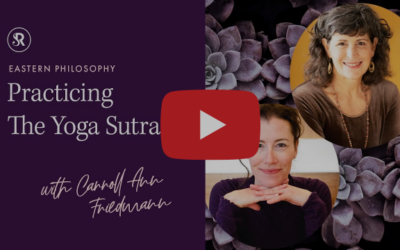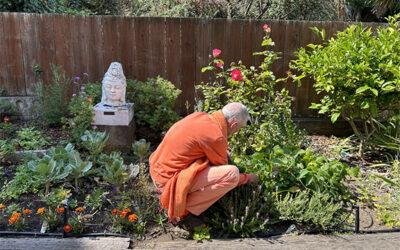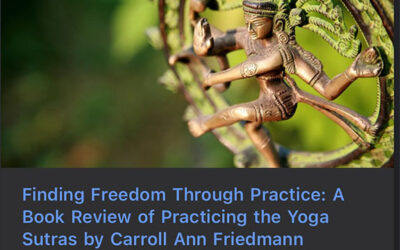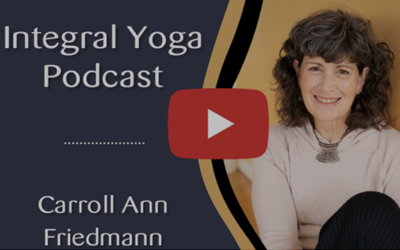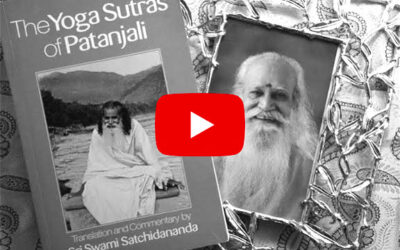Veganism and the Yamas: A Yogic Call to Compassion Yoga is a path of transformation—one that extends far beyond the mat. It is a way of living that aligns our thoughts, words, and actions with our highest ideals. The eight limbs of Raja Yoga, as outlined by Patanjali,...
Breath, Body and Brain Aligned
While Sri Patanjali and other classical Yoga sources have known this for several thousand years, recent medical research highlights the profound connection between breath, body, and mind, emphasizing breathwork as a tool for emotional regulation and stress relief....
A Journey into the Yoga Sutras
Enjoy watching/listening to Yoga teacher Rachel Scott's podcast in which she is in conversation with Integral Yoga Publications author Carroll Ann (Prashanti) Friedman. Prashanti discusses her new book, Practicing the Yoga Sutras: A Personal Study Guide and Journal....
Practice and Non-Attachment: A Two Pronged Approach to Liberation
If you want to see well through a window, you have to clean both sides. Practice (abhyasa) and non-attachment (vairagya) work much the same way. They are the complimentary practices given in Patanjali’s Yoga Sutras as a means to quiet the movement of thought in the...
Ishvara Pranidhana: The Psychology of Surrender
On the journey of self-growth, one of the central concepts in yogic philosophy is Ishvara Pranidhana, or the act of surrendering to a Higher Power. Patanjali, in the Yoga Sutras, describes it as a foundational practice that leads us toward liberation and inner peace....
YogaU Reviews “Practicing the Yoga Sutras”
YogaUOnline.com just posted an inspiring review of Integral Yoga Publications' latest release, Practicing the Yoga Sutras by Carroll Ann (Prashanti) Friedmann. Yoga U founder Sarah Bell shared that what was particularly helpful in her reading of the text, was how...
Integral Psychology of Yoga
Introduction The art and science of Yoga, one of the greatest treasures of India's unique cultural heritage, has much to offer in terms of understanding the human mind. Yoga treats the human being as a multi-layered conscious being, possessing three bodies (sthula,...
What It Really Means to “Practice” The Yoga Sutras
In this episode of the Integral Yoga Podcast, Avi Gordon (director of the Integral Yoga Teachers Association) is in conversation with Carroll Ann (Prashanti) Friedmann. She shares her personal journey with the Yoga Sutras of Patanjali and the sankalpa (vow or...
Who Are You? Who Are You Being? Svadhyaya – “Self-Study”
Who am I really? Who am I being? These are two queries and discoveries to be made while practicing svadhyaya (self-study)—Yoga’s fourth niyama, as well as the second practice in the Kriya Yoga of Sri Patanjali. Svadhyaya includes the study of sacred texts and the...
Spiritual Media Blog Podcast: Practicing the Yoga Sutras in Daily Life
Matthew Welsh, JD, PhD, (founder of Spiritual Media Blog and his podcast of the same name) recently invited Carroll Ann (Prashanti) Friedmann to be a podcast guest and talk about her new book (Practicing the Yoga Sutras, from Integral Yoga Publications). The book...
Practicing the Yoga Sutras
Integral Yoga® Publications is pleased to announce this new release: Practicing the Yoga Sutras: A Personal Study Guide & Journal by Carroll Ann (Prashanti) Friedmann. The book, which utilizes the sutra translations and definitions from The Yoga Sutras of...
Using the Yoga Sutras in Daily Life
We all get those physical signs of stress and anxiety. We might feel tired or have random aches and pains and can’t pinpoint the source. We stretch, we breathe, and we feel rejuvenated right afterwards. But after a few days the same aches and pains are back, and...
Yoga Sutras of Patanjali Video Series
Join Integral Yoga Master Teacher Nalanie Chellaram as she teaches the Yoga Sutras of Patanjali. The series begins with an overview of the text and why it is such an inspiration to so many. Utilizing the commentaries by Swami Satchidananda, along with insights from...
The Kleshas: Exploring the Elusiveness of Happiness
The kleshas are Yoga’s framework for understanding the discord between our desires and our lived experience. Deborah Adele’s new book, The Kleshas: Exploring the Elusiveness of Happiness, lays open the insight and wisdom of the sage Patanjali, as described in the Yoga...
The Real Yoga
The essential teaching and goal of Yoga is to make the mind calm. “Yoga chitta vritti nirodha,” says the Yoga Sutras of Patanjali. That means that Yoga is the calming of the waves created in the chitta, the mind by keeping the mind balanced under all conditions. In...
Questions and Answers on the Yamas
Q: In the Ramayana and Mahabharata, it’s clear that there was killing. The Gita itself takes place on a battlefield. How is this explained and justified in terms of ahimsa (non-violence)? Swami Satchidananda: In the Bhagavad Gita, Krishna talks about non‑violence to...



